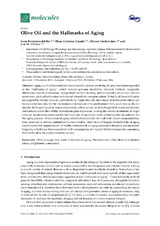Olive Oil and the Hallmarks of Aging
Autor
Fernández del Río, Lucía
Gutiérrez-Casado, Elena
Varela-López, Alfonso
Villalba, José Manuel
Editor
MDPIFecha
2016Materia
DNA damageFatty acids
Hallmarks of aging
Mediterranean diet
Olive oil
Oxidative stress
Polyphenols
Senescence
METS:
Mostrar el registro METSPREMIS:
Mostrar el registro PREMISMetadatos
Mostrar el registro completo del ítemResumen
Aging is a multifactorial and tissue-specific process involving diverse alterations regardedas the “hallmarks of aging”, which include genomic instability, telomere attrition, epigenetic alterations, loss of proteostasis, deregulated nutrient sensing, mitochondrial dysfunction, celular senescence, stem cell exhaustion and altered intracellular communication. Virtually all these hallmarks are targeted by dietary olive oil, particularly by virgin olive oil, since many of its beneficial effects can be accounted not only for the monounsaturated nature of its predominant fatty acid (oleic acid), but also for the bioactivity of its minor compounds, which can act on cells though both direct and indirect mechanisms due to their ability to modulate gene expression. Among the minor constituents of virgin olive oil, secoiridoids stand out for their capacity to modulate many pathways that are relevant for the aging process. Attenuation of aging-related alterations by olive oil or its minor compounds has been observed in cellular, animal and human models. How olive oil targets the hallmarks of aging could explain the improvement of health, reduced risk of aging-associated diseases, and increased longevity which have been associated with consumption of a typical Mediterranean diet containing this edible oil as the predominant fat source

